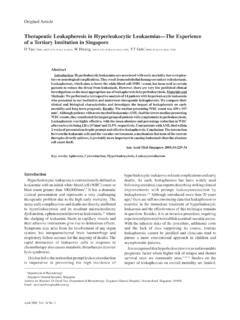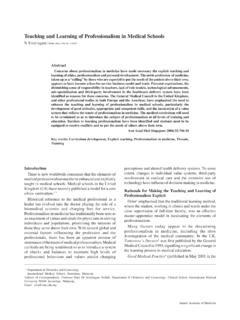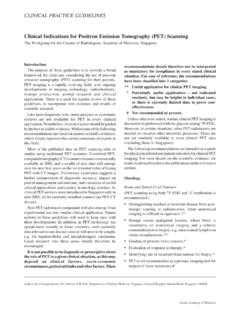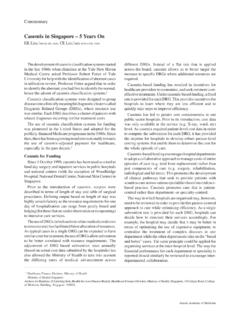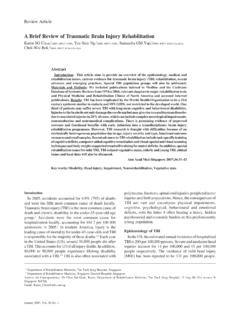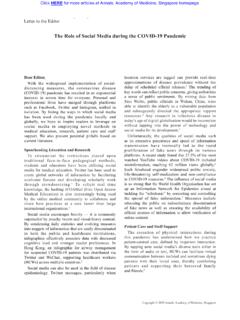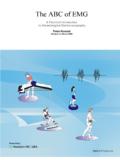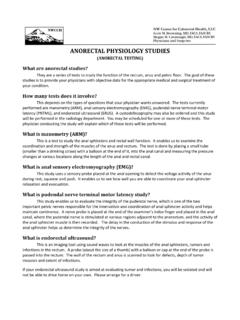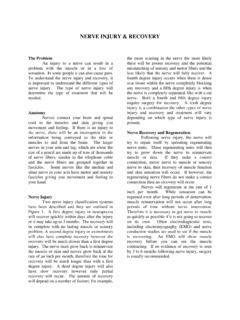Transcription of Suprascapular Nerve Neuropathy Secondary to …
1 1032 Annals Academy of MedicineSuprascapular Nerve Neuropathy Bernard CS Lee et alCase ReportSuprascapular Nerve Neuropathy Secondary to Spinoglenoid Notch Ganglion Cyst:Case Reports and Review of LiteratureBernard CS Lee,1 MBBS, MRCS (Edin), Muthukaruppan Yegappan,2 MBBS, FRCS (Glas, Edin), FAMS, Palaniappan Thiagarajan,3 FRCS (Glas), MCh, FAMS1 National Healthcare Group, Singapore2 Department of Orthopaedics, Tan Tock Seng Hospital, Singapore3 Orthopaedic Sports Medicine, Mt Elizabeth Medical Centre, SingaporeAddress for Correspondence: Dr Bernard Lee Chee Siang, 52A Toh Tuck Road, #05-09 Singapore : Suprascapular Nerve Neuropathy Secondary to ganglion cyst impingement hasincreasingly been found to be a cause of shoulder pain. Clinical Picture: We present 2 patientswho complained of dull, poorly localised shoulder pain, which worsened with overhead resonance imaging showed ganglion cysts in the spinoglenoid notch.
2 Treatment: Bothpatients failed conservative management with physiotherapy and underwent shoulder patient underwent arthroscopic decompression of the cyst and the other had open excisionof the cyst. Outcome: Both patients experienced resolution of symptoms within 6 months ofsurgery. Conclusion: With appropriate treatment, Suprascapular Nerve Neuropathy secondaryto ganglion cyst impingement is a treatable condition with potentially good Acad Med Singapore 2007;36:1032-5 Key words: Impingement, ShoulderIntroductionShoulder pain and dysfunction have long been the baneof both the young and old alike. Common causes includelocal conditions such as rotator cuff tears, impingementsyndromes, tendonitis, bursitis, adhesive capsulitis,acromioclavicular joint osteoarthritis, as well as cervicalpathology such as disc disease and spondylosis.
3 Supra-scapular Nerve Neuropathy has increasingly been found tobe a cause of shoulder pain and dysfunction, especiallywith the advent of magnetic resonance imaging (MRI) andits use in evaluating shoulder pathology. With appropriatetreatment, it has been shown that this is a treatable conditionwith potentially good results. We present 2 patients withspinoglenoid ganglion cysts as a cause of supraspinatusnerve ReportsCase 1A 23-year-old full-time national serviceman (army)presented with the complaint of right posterior shoulderpain for 9 months. He also noted difficulty, particularlywith overhead activities. He denied any history of traumaor injury to his examination revealed full shoulder range ofmotion with no clinical evidence of muscle wasting,weakness or shoulder instability.
4 The initial impressionwas that of a labral tear. He was initially treated withphysiotherapy but showed no improvement. A subsequentshoulder MRI revealed a ganglion cyst in the spinoglenoidnotch (Fig. 1).A further course of conservative management with non-steroidal anti-inflammatory drugs (NSAIDs) andphysiotherapy for 3 months produced no improvement. Anelective arthroscopic decompression of the cyst was thencarried standard posterior portal was used for the viewingarthroscope. Ganglion cysts are usually associated withgrade 2 labral tears which create a valve-like effect, verysimilar to the horizontal cleavage tears of knee menisciwhich are associated with meniscal cysts. However, in thispatient we found only a grade 1 labral tear with just frayingintraoperatively.
5 It is possible that the tear was alreadyhealing. The capsulotomy was performed using an accessoryposterolateral portal and decompression of the cyst wascarried out. Since the bleeding was adequate, the labrumwas not repaired using anchors or plain sutures. It was leftto heal on its , the pain subsided slowly, with completeresolution of pain after 4 months. Postoperative MRI at 3months revealed cyst resolution (Fig. 2). He has sincereturned to full 2007, Vol. 36 No. 121033 Suprascapular Nerve Neuropathy Bernard CS Lee et alCase 2A 62-year-old lady presented with vague shoulder painof several months. This was exacerbated by overheadactivities. She also complained of difficulty sleeping due tothe examination revealed full shoulder range ofmotion. There was no painful arc, nor any muscle wastingor weakness.
6 The impression at the time was that of arotator cuff tendonitis or tear and she was treated withanalgesia and physiotherapy with no improvement. AnMRI of the shoulder was subsequently done revealing aspinoglenoid notch ganglion failure of a further trial of non-operative treatment,shoulder arthroscopy was done, revealing no labralpathology. The decision to do an open decompression wasmade as the cyst was large. A posterior approach was usedand the infraspinatus was split to minimise postoperativepain. The main issue with dissection is the suprascapularnerve which runs inferolaterally in the spinoglenoid notchand curves around the lateral margin of the scapular spineto enter the infraspinatus fossa. The ganglion, however, laysuperior to the Nerve and as such the dissection wasperformed more superiorly and the ganglion was did not try to locate the Suprascapular , she had slow resolution of symptomsover 3 months.
7 By 6 months, she had complete resolutionof symptoms and the muscle wasting had both patients, the operated shoulder was supported ina sling for 10 days and they were encouraged to perform fullrange of active and passive movements immediately. Wedid not restrict the patients shoulder movementspostoperatively, as is the usual practice with other shoulderrepairs where shoulder immobilisation is Suprascapular Nerve is a mixed peripheral Nerve thatarises from C5 and C6 roots with variable contributionfrom C4. The Nerve runs to the Suprascapular notch and liesin close relation to the posterior border of the clavicle. Thesuprascapular ligament forms the roof of the suprascapularnotch, under which the Nerve runs. The Nerve theninnervates the supraspinatus muscle as it enters thesupraspinatus fossa, and receives sensory andproprioceptive branches from the glenohumeraland acromioclavicular joints, as well as thesubacromial bursa and posterior aspect of thecapsule.
8 In up to 15% of individuals, the Nerve alsoreceives cutaneous afferents from the lateral Nerve then runs inferolaterally where it wrapsaround the lateral margin of the scapular spine topass through the spinoglenoid notch into theinfraspinatus fossa, where it is a pure motor nervesupplying the infraspinatus muscle. Thespinoglenoid ligament (inferior transverse scapularFig. 1. Preoperative shoulder 2. Postoperative shoulder ) is a fibrous connective tissue band which runsfrom the lateral border of the scapular spine to the marginof the glenoid process. This ligament has been reportedwith variable prevalence and morphology in cadavericshoulders1 with higher prevalence noted in men than et al2 showed in their anatomical specimens that theligament was present in 87% of males, while it was onlypresent in 50% of Nerve entrapment/dysfunction at thesuprascapular notch was first officially described in Nerve entrapment at the spinoglenoid notchwas subsequently reported in Nerve Neuropathy can occur as a result oftraction, trauma, infection or extrinsic compression by aspace-occupying lesion.
9 Traction injuries more commonlyoccur at the Suprascapular notch where the Nerve risksgetting tethered, especially with repetitive overhead activi-ties. At the spinoglenoid notch, cross-body adduction andinternal rotation of the glenohumeral joint has also beenshown to tighten the spinoglenoid ligament, resulting in thestretching of the Suprascapular Nerve which moves laterallyunderneath the Trauma commonly occurs dur-ing shoulder dislocations or fractures of the proximalhumerus or scapular. Iatrogenic injury also follows distalclavicle resection, Nerve traction during intraoperativepositioning under general anaesthesia, shoulder arthrod-esis and in the posterior surgical approach to the Nerve neuritis has also been shown to be acause of Suprascapular Nerve Neuropathy .
10 Finally, the su-prascapular Nerve can be compressed by ganglion cysts,tumours or haematomas. As mentioned earlier, these gan-glia are believed to develop when capsulolabral injuriescreate a valve-like effect and force synovial fluid into thesurrounding tissues, similar to the way meniscal tears of theknee are believed to lead to meniscal cysts. Several authorshave noted the high incidence of labral injuries with thepresence of adjacent with Suprascapular Neuropathy frequently present1034 Annals Academy of MedicineSuprascapular Nerve Neuropathy Bernard CS Lee et alwith pain and weakness. The pain is usually a dull, poorlylocalised ache over the posterolateral aspect of the shoulder,which may also radiate to the neck, arm or chest wall. Thepain is usually worse with overhead activities and it is alsomore common if the pathology is at the Suprascapular notchrather than at the spinoglenoid notch.
